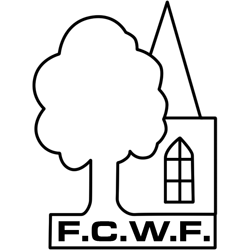How the Reserve is managed
Childwall Woods and Fields is owned by Liverpool City Council and it is responsible for the reserve. In practice, most of the day to day management is done by a voluntary group, the Friends of Childwall Woods and Fields. The Council gets involved mainly if there is major tree work to be done.
One question the Friends are often asked is why does the reserve need managing? Why can’t you just leave it alone, stop interfering and let nature do its thing?
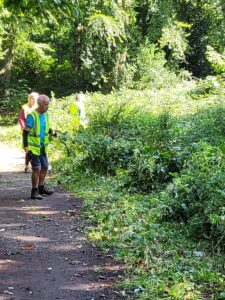
This is a reasonable question especially when some of the management work we do looks so destructive – removing colourful Rhododendron, or clearing brambles and invasive plants like Japanese knotweed or Himalayan balsam.
But the fact is that, though the reserve is a place for nature, the Habitats it contains are actually man made and many are very dynamic. If you just leave grassland or a glade, scrub invades and the meadows and wildflowers will disappear. If you leave the Rhododendron unchecked it will spread and kill the bluebells.
To do nothing is a decision to lose habitats and species.
Our aim in managing the Childwall Woods and Fields is to preserve and enhance the habitats and biodiversity in the reserve, and each of these habitats present its own challenges.
Childwall Woods and Fields is not just for nature – it is for people too. It is a place for people to visit, to exercise, connect with nature and de-stress. This means that our other focus is managing access, keeping the paths open and safe and introducing new signage.
The Friends are enormously grateful to the volunteers who give their time to do this management work.
The Friends welcome your comments and questions about the work we are doing in looking after Childwall Woods and Fields. Please get in touch via Facebook or Instagram, or via our contact page.
1. Managing the Woods – removing Rhododendron, protecting the bluebells and planting trees
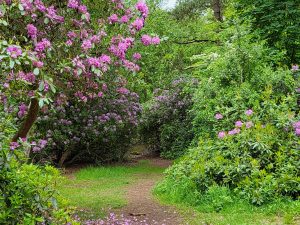 Rhododendron was planted more than a hundred years ago in the ornamental gardens in the Northern part of the woods. It looks lovely but, left unchecked, it is a serious pest.
Rhododendron was planted more than a hundred years ago in the ornamental gardens in the Northern part of the woods. It looks lovely but, left unchecked, it is a serious pest.
But let us be clear, it’s not all Rhododendrons that are a problem. We are proud of our collection of ornamental Rhododendron near the Folly or Monkey Island – some of which are very rare. No one is going to cut these down. Most of these are hybrids and they are infertile. No, the problem is with the common or garden Rhododendron ponticum with the purple flowers which spreads both by seeds and suckers.
The Woodland Trust calls Rhododendron ponticum ‘A devil in disguise’. It is classified as an invasive non-native species that destroys habitats and animals with its toxicity. It makes the soil very acid and this prevents other plants from germinating and growing. Nothing grows underneath it. The government’s guidance from Natural England is also clear- Rhododendron ponticum should be removed.
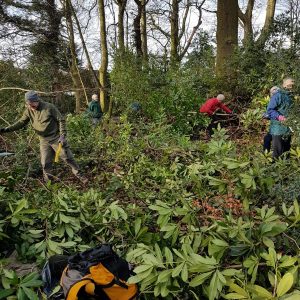
Left unchecked, Rhododendron ponticum continues to spread throughout the woods killing the native flowers on the woodland floor. This is especially important here because of the bluebells that are found in the woods.
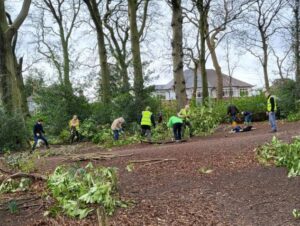
This is why we are clearing the Rhododendron ponticum in the southern woods and using the unwanted branches to make ‘dead hedges’ to shield the woodland bluebell areas from trampling where thousands of bluebells and daffodils are on their way through.
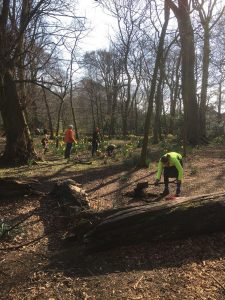
The other winter activity in the woods is planting new trees including oak, hazel and rowan, especially on either side of the path from the Countisbury Drive gate towards Woolton Road.
These native trees will increase the biodiversity of the site and provide food for wildlife for years to come.
2. Grassland & Glade Management – What are we cutting and why?
Childwall Fields is a habitat mosaic, meaning it includes a close mix of different habitat types. These areas combine to give the Fields their character and nature conservation value.
Left to their own devices, however, habitats change, open grassland and glades are encroached by bramble and then woodland.
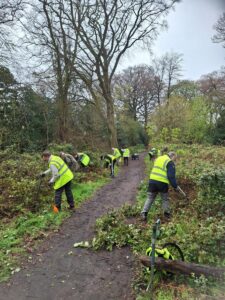
Management of the Fields aims to maintain the balance of the present mosaic by mowing some of the best open grassland areas and flailing back some edges of the encroaching bramble to keep this in check. We have also been controlling the bramble within the woodland glades (above).
Cutting some of the better open grassland areas will also have the benefit of breaking up the accumulated thatch within the grasses here, which will hopefully encourage more flowering species over time.
To assist in this and promote diversity, an annual wildflower called Yellow Rattle has been seeded into the cut areas. This flower is parasitic on grasses and will help reduce their vigour, allowing less competitive wildflowers to survive within the grassland.
Additionally, wildflower plugs have been planted within the grassland, adding to the overall diversity and helping develop areas of the open grassland as meadows. This has worked well in the past, with Ragged Robin, Devils Bit Scabious and Meadowsweet all being planted on the fields previously, and now freely spreading. We have added to these vetch, cowslip, knapweed, teasel and Greater Burnet.
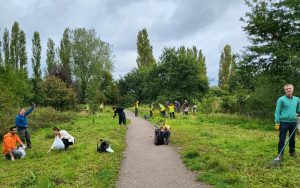
As part of the Habitat and Access Improvement Project, some developing tree cover has been removed on the top field especially in the open grassland areas where it was starting to shade out the open grassland Orchid community.
We’ve had some comments that it seems strange to be cutting areas of the fields. This work can appear destructive but it will be worth it in the long term to maintain and enhance the grassland’s wildlife and habitat value.
As ever there’s a balance to be struck, so while some better areas will be cut, much of the open grassland will be left untouched to provide a refuge for small mammals and many of the invertebrate species associated with longer and tussocky grassland.
3. Scrub – our battle with invaders
Scrub is our most dynamic habitat and the one that demands the most time and effort to manage. Scrub is the halfway house between grassland and woodland – the shoulder high mix of nettle, thistles, bindweed, bramble, small trees and bushes that can be seen particularly on the middle and lower fields. It loves to spread, particularly across paths!
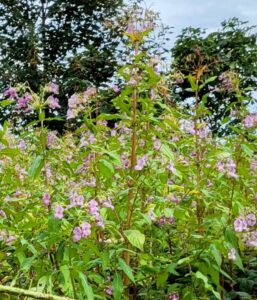
And scrub itself is also being invaded. We are well into a 5 year plan to control Japanese Knotweed, thanks to David Holland, one of the Trustees who is an expert on Japanese Knotweed control. Now we face a new invader, Himalayan Balsam, the 2m high pretty purple and white flower that now floods the lower fields, growing through bramble and nettle and under the trees in the plantation. Our battle against it is just beginning.
Himalayan Balsam is phenomenally invasive as the seeds can be flipped 5 metres from the 2.5m high parent by a clever explosive spring mechanism. 30 seeds in each flower, 50 flowers to a plant. 1500 seeds!!! Nothing grows under the heavy leaf cover (except bramble).
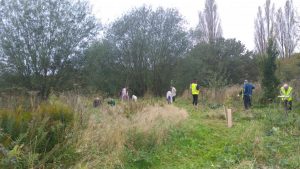 We have planted 20 fruit trees in a small Orchard on the Middle Field (above). One of the regular management tasks is to rescue them from a profusion of head high nettle, bramble and goose-grass.
We have planted 20 fruit trees in a small Orchard on the Middle Field (above). One of the regular management tasks is to rescue them from a profusion of head high nettle, bramble and goose-grass.
4. Ponds and wetlands
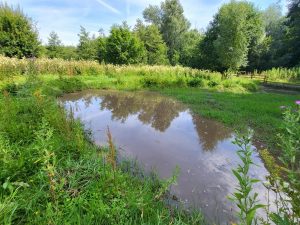
One of the most important parts of the Habitat and Access Improvement Project was the work to dig ponds and scrapes (shallow seasonal pools) on the top field. This took place in 2022 and 2023 in the area by the woods where reed mace (bullrushes) can be seen. This area is known to be prone to flooding so it was the ideal place to develop our new wetland area. This will be a major habitat area for the future and contribute enormously to the biodiversity of the reserve.
So far management has been fairly straightforward – planting appropriate native wetland plants. We are keen not to introduce invasive, non native plants. (If you have a pest pond plant that is choking your pond, please don’t donate it to our new ponds. We don’t want it either!)
5. Managing access and keeping paths clear
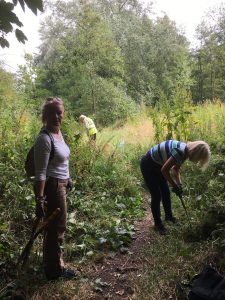
Keeping the paths clear is a year round activity. In the summer it’s a matter of cutting back the encroaching grass, nettles and brambles, especially on the middle and lower fields. In winter, it’s a matter of clearing accumulations of dead leaves and mud so that the paths remain passable and are not made much wider by people walking round the difficult places.
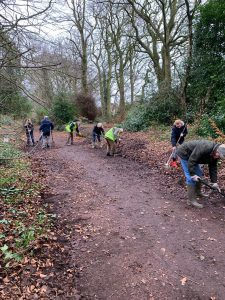
Author: Andrew Scott, January 2024

